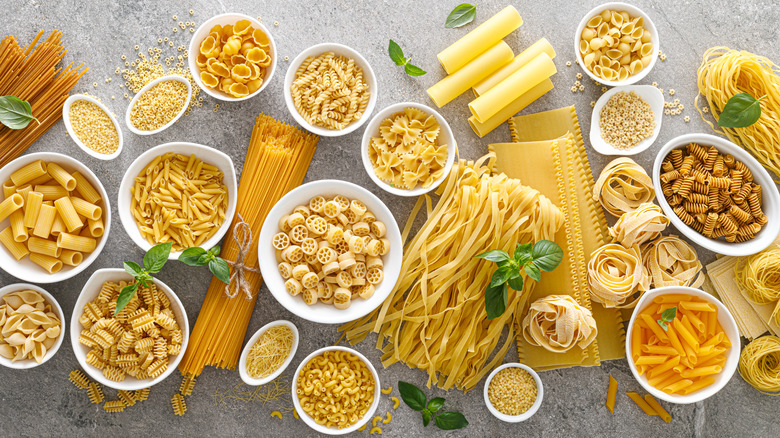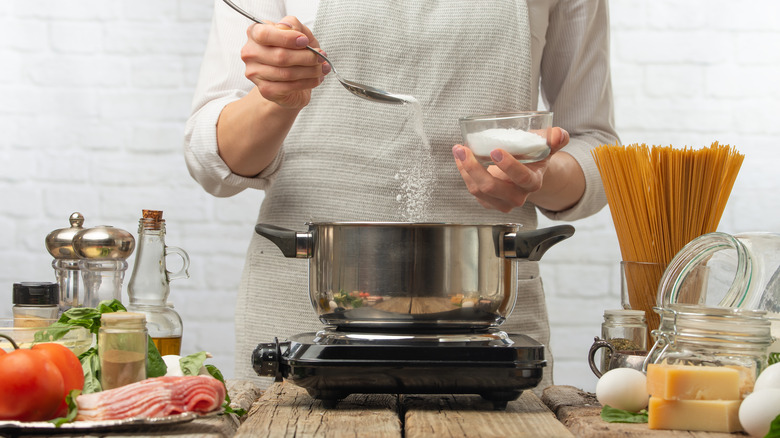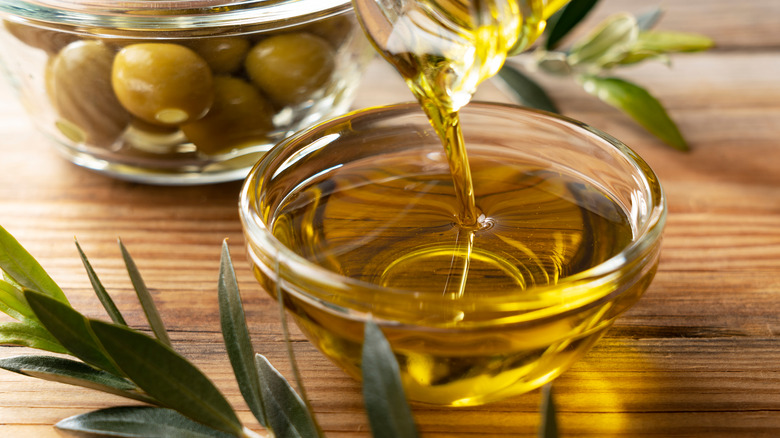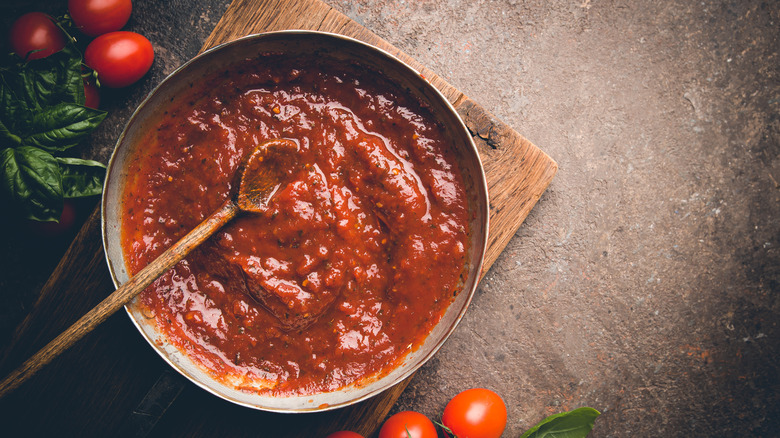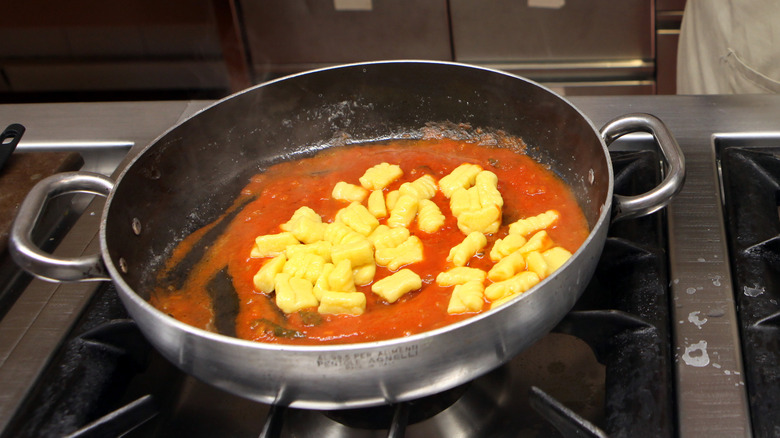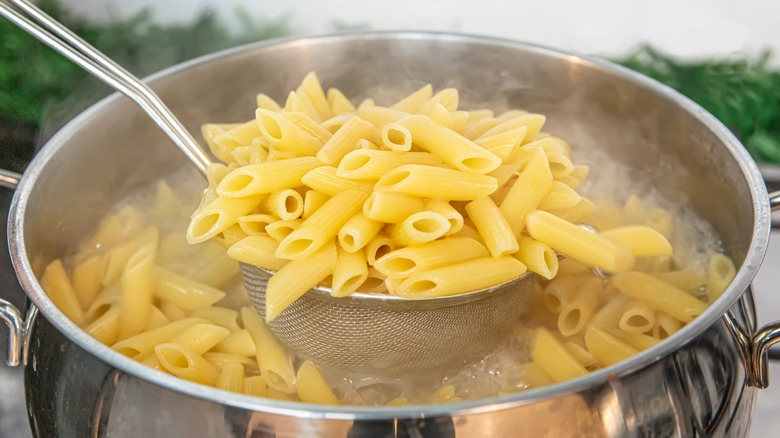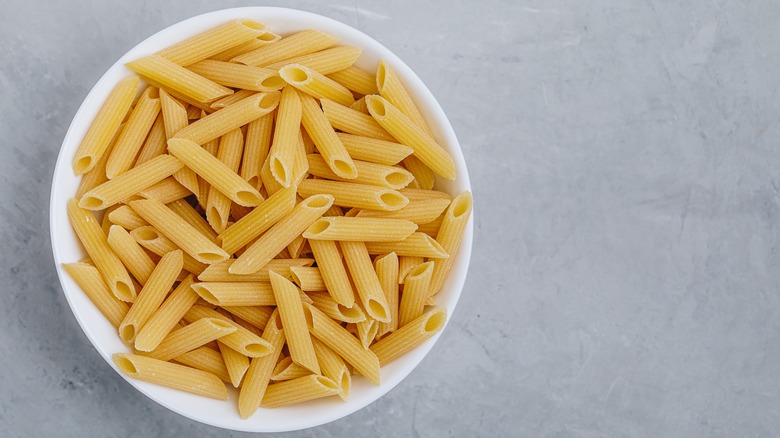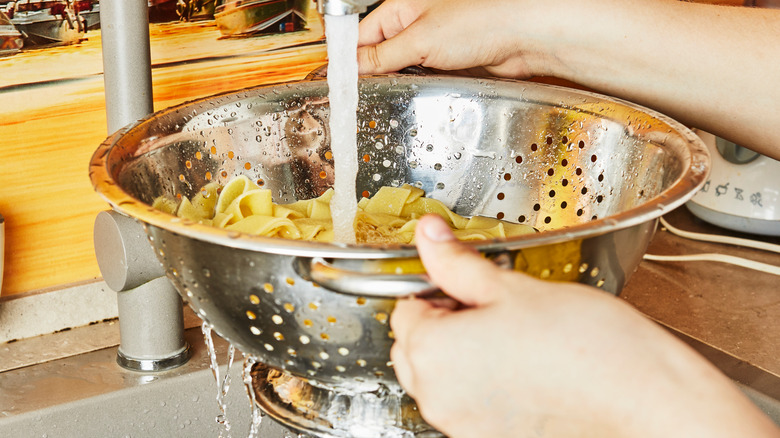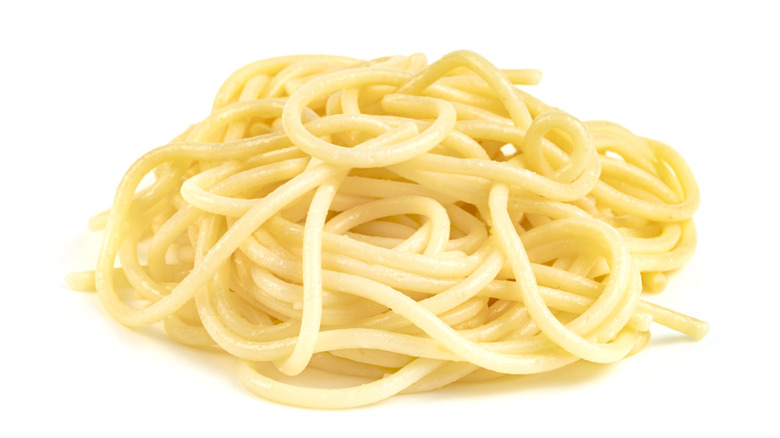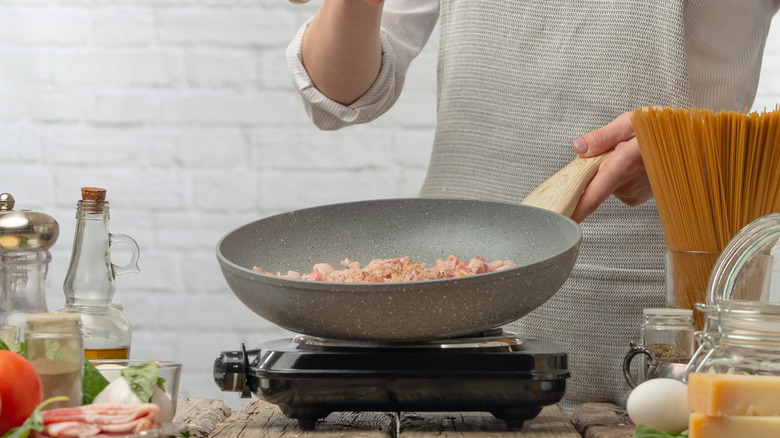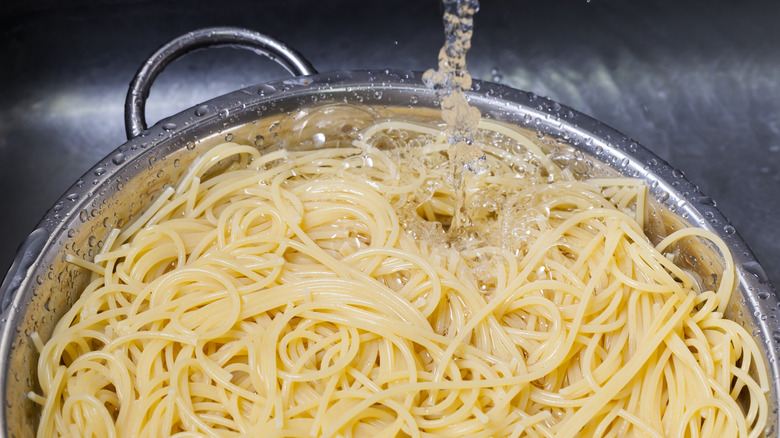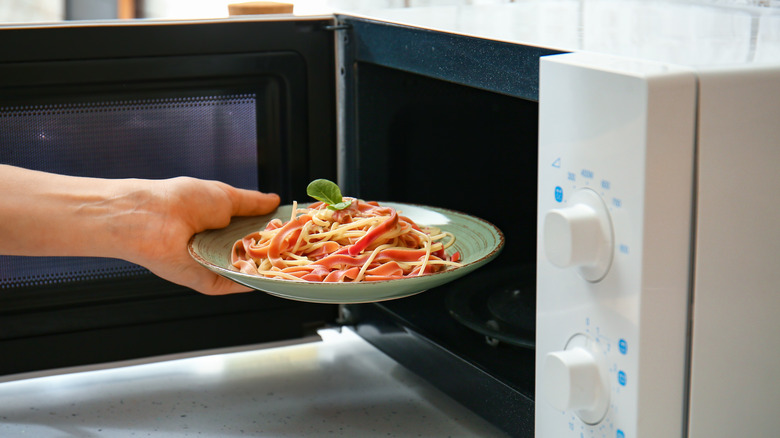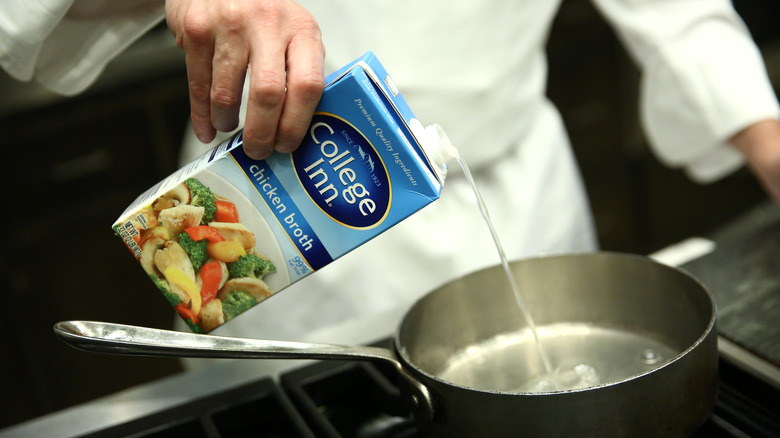12 Pasta Cooking Hacks You'll Wish You Knew Sooner
Pasta is one of the most versatile foods in your pantry. It's shelf-stable, which means you don't have to use it up right away, and you can pair it with just about anything: veggies, meat, tofu, beans ... there are never-ending possibilities. But, just because you always have it around doesn't necessarily mean you're cooking it in the best possible way. If your pasta ever comes out tasting bland, mushy, or too al dente, you may be looking for some help for your next pasta dish.
Luckily, we've got you covered. We're taking a look at some of the most useful pasta cooking hacks that we use in our own kitchen. Whether you're just learning how to cook pasta for the first time, or you want to improve your skills to impress friends on your next pasta night, these hacks will take your just "ehh" pasta to a whole new level. And the best part? Most of these hacks are super easy to implement in your own kitchen. So, what are you waiting for?
Make your pasta water salty — like really salty
You've heard it before, and you'll hear it again. If you want your pasta to come out as flavorful as possible, it's important to salt your pasta water. Most people probably know this important step at this point, but how do you know that you're really adding enough salt to your water? A lot of home cooks aren't, and it's obvious once you bite into a noodle and are greeted with a blandness instead of a wonderfully robust flavor.
If you want to measure to ensure you're getting just the right amount of salt in your water, you may want to try a teaspoon and a half of table salt for every liter of water in the pot. Keep in mind, though, that not all salt is equally salty — kosher salt is not as intense as table salt. However, if you're not the measuring type, that's totally okay. Another good rule of thumb is that your pasta water should be "salty like the sea." Give it a taste before you add your pasta, and make sure it tastes like the ocean on a hot day.
Of course, it is possible to add too much salt to your water, so if you're not used to the process, be sure to taste as you go. The last thing you want is to make your pasta so salty that it's practically inedible.
Don't add olive oil to the water
After you've added your salt to the water, you might assume that it's time to add another important ingredient: olive oil. You may have heard that adding olive oil to your pasta water will prevent your pasta from sticking together, but we're here with some news you may not like to hear — adding olive oil to your pasta water is actually not a good idea.
The main issue with the addition of olive oil in pasta water is the fact that the oil can prevent the sauce from properly sticking to your pasta. You want every strand to be coated in that sauce for maximum flavor (and the perfect texture), so adding that olive oil is generally going to be a mistake.
That being said, if you plan on using an olive oil-based sauce for your dish, adding olive oil to the water probably isn't going to have much of an effect on the end product. But, in that case, why would you want to waste your good olive oil if you're — quite literally — just going to throw it down the drain? Save it for the sauce.
Make your own pasta sauce
This one is more a matter of personal preference, but if you ask us, the best pasta includes homemade sauce. Jarred pasta sauce can be convenient if you're at the tail end of a busy day and you're just trying to get your dinner finished as quickly as possible. If you're really going for the best possible taste, jarred pasta sauce is not where it's at. The main downside is that you don't really know what's in it. Some grocery store marinara sauces contain a shocking amount of sugar — probably not what you're going for on pasta night.
But, when you make your own pasta sauce, you'll know exactly what you're eating. If you don't have fresh tomatoes on hand, you can always use the canned variety (which may be easier to work with anyway), or you can opt for an olive oil-based sauce if you're looking for something quick and easy. While cooking your own sauce may seem like a long, drawn-out process, it's possible to throw an easy sauce together in a matter of minutes.
It may seem like a hassle, but trust us: Making your own pasta sauce at home will definitely take your pasta dishes to a whole new level.
Boil your pasta in the sauce
Here's a pasta hack that could save you considerable time in the kitchen, which is perfect for those days when you're trying to get dinner on the table quickly or you're running late on dinner party prep. Instead of boiling your pasta in its own pot of water, why not cook it directly in the sauce?
Here's how to do it easily: Make a tomato sauce with canned tomatoes, garlic, onions, and whatever else you usually add to your homemade sauce. Then, add some water to the sauce as well. It's not going to look appetizing, at first, but it will all come together. That pasta is going to absorb the water, so once it's done cooking, all you're left with is cooked pasta and a delicious, rich sauce.
This is a great move because the starch from the cooked pasta is also going to make your sauce thicker. Plus, it saves you time and energy in the kitchen. The best part is that you only have one pan to clean up. When you're trying to get dinner on the table in a pinch, this is one of the best pasta hacks to employ.
Utilize your pasta water to improve sauces
That takes us to our next tip, which is one of our all-time favorite cooking tips. When you cook pasta, you're actually producing a very valuable ingredient. But unfortunately, a lot of home cooks simply pour this ingredient down the drain. That special ingredient is pasta water, and Bon Appétit refers to it as "liquid gold." That may sound dramatic, but pasta water really can transform your sauce and your finished dish.
When you boil your pasta in water, starch is released, which is why the water looks murky. When you add this starch to a fat-based sauce, it creates a lovely, silky texture that's otherwise difficult to achieve. Therefore, when your pasta is finished cooking, you shouldn't throw the pasta water down the sink. Instead, reserve some of the water in a container to use later. Then, when you're making your sauce and adding the pasta to the dish, you can pour in some of that reserved pasta water. You'll be amazed at how it can transform an average sauce into something really special.
The best part is this means you don't have to try to juggle an unwieldy colander when you're transferring your pasta from the pot into the sauce pan. Instead, just use a pair of tongs to move the pasta from one vessel to another. That way, you don't even need a separate container for the pasta water.
Choose the right pasta shape for your sauce
Any pasta shape can go with any type of sauce, right? That may seem like the case, and we're certainly not going to stop you from combining any pasta and sauce you feel like mixing together. But, if you want to get the most out of your dish, it's a good idea to know which pasta shapes pair best with which sauces.
For example, DeLallo recommends using a shorter pasta shape for baked dishes. The Italian market says gemelli, orzo, and penne are great options for this kind of dish, but don't be afraid to branch out and try new pasta shapes that you may be unfamiliar with. When you're preparing a butter or oil-based sauce, a longer, more delicate pasta shape may be a better way to go. DeLallo recommends fettuccini, spaghetti, and bucatini as solid choices. And when you're making a cream sauce, you'll want something that's heartier and can stand up to the thickness of the sauce. Forget about the capellini and instead opt for orecchiette or farfalle.
Sticking to these guidelines when you're just starting out in your pasta-making journey is a great way to ensure you're not pairing a pasta with a sauce that's objectively wrong for it. Once you get a better sense of the pastas you're working with, and the sauces you usually cook, you can branch out and try new, different combos.
Know when to — and when not to — rinse your pasta
For some people, there's no question that you should always rinse your pasta after it's finished cooking. If you're the kind who immediately pulls out the colander and turns on the faucet, you may want to think more carefully about what you're doing. There are some instances when rinsing your pasta makes sense. However, most of the time, you'll probably want to avoid it.
We found there are two main instances in which you should rinse your pasta. The first is when you're making pasta salad. You don't want that extra buildup of starch on your noodles and taking the time to rinse them prevents that. It can also help you cool down your pasta if you're planning on making a pasta salad that you're going to eat right away. Additionally, rinsing is generally a good idea when you're making a stir-fry because that extra starch could get clumpy and messy in the pan.
But, when you're serving a hot pasta dish with sauce, refrain from rinsing. You'll want that extra starch to make your sauce thicker and creamier.
Use olive oil on your leftover pasta
For some people, the thought of even having leftover pasta in the house is unheard of — how do you not eat it all on the spot? But, if you're the kind of person who likes to cook some extra pasta to save for later, then you may find this hack helpful. If you find that your leftover pasta tends to clump together, you may want to add some olive oil to the noodles before refrigerating. This extra bit of fat will cling to the pasta, preventing the pieces from sticking to each other.
Of course, it's important to remember that you'll want to take this step after you remove the pasta from the pasta water. Otherwise, you'll be wasting a lot of that valuable oil. Also, this tends to work best if you'll be using an olive oil-based sauce with the pasta later.
Cook your pasta in a shallow pan, not a pot
If you have a stovetop that takes forever to heat up, then you know that waiting for pasta water to boil can be a patience-testing process. This is especially true if you're cooking a lot of pasta all at once — the more water there is, the longer it takes to boil. If you don't want to be standing there forever, just waiting for those first few bubbles to pop up, you should consider trying this Chowhound hack: Instead of cooking your pasta in a pot, try heating up a flat pan of hot water. Because the water is spread more evenly across the heating element, it will start boiling faster. Then, you can add your pasta to the pan and get cooking faster.
This hack can also help your longer pastas cook more uniformly. If you're cooking spaghetti in a small pot, parts of the noodles are going to be sticking out of the water when you first place them in the pot. That means that half of the pasta is getting cooked longer than the other half. Cooking your pasta in a large, shallow pan prevents this kind of uneven cooking.
Don't precook your baked pasta
Making a baked pasta dish and in a rush? You may think that you have to pre-cook your pasta before you put your dish in the oven, but as it turns out, that's not always the case. According to Oregon Live, you don't really have to pre-cook pasta that's going to end up in the oven anyway. Instead of turning on the stove, simply allow your pasta to soak in salted water for about 45 minutes. Yes, this does dirty a dish, but you don't have to stand around watching the boiling water. Once you've soaked your pasta, you can then drain it and add it directly to the dish with your other ingredients.
As long as there's enough liquid in the sauce, Oregon Live says the pasta will come out of the oven nice and tender with that slightly burnt crispness we all love. Who knew that making baked pasta could be so easy?
Know how to properly reheat your pasta
So, you made a big pasta dish last night, and it didn't get finished before you went to sleep. That's great news — who doesn't love an easy pasta lunch the next day? But, if you're like us, then you've struggled with reheating your pasta in the past. It's so easy for reheated pasta to come out clumpy, dry, or just plain unappetizing.
There are a few methods for reheating pasta you can try. If you're trying to reheat a large serving of pasta, putting it in the oven may be your best bet. Of course, this works well for baked pasta dishes, but if can also work for pasta cooked on the stove if you don't mind a slight change in texture.
If you're reheating your pasta in the microwave instead, remember to add a bit of water to the dish to ensure the pasta doesn't get dried out. You can use a similar method if you're reheating your pasta on the stove — make sure to steam it a bit so you don't have to contend with hard, crunchy noodles.
Cook your pasta in broth or stock
Try this hack once, and we'll bet that you'll never cook your pasta in plain water again. Instead of boiling your pasta in plain (albeit salted) water, why not add broth or stock to the pot instead? Then, when the pasta absorbs the liquid, it will already be imbued with flavor. This cooking method originated in Italy's Emilia-Romagna region, and it results in a more flavorful pasta dish, regardless of what sauce you opt for after you boil your pasta.
You can keep things simple by sticking to the standard chicken broth or stock you already have in your pantry. Opting for beef stock can give the pasta an even richer flavor. But, you don't have to stop there. You can also use a veggie stock made from vegetable scraps or opt for bone broth for a bit more complexity. Add a ton of extra flavor to your pasta — and it takes basically no additional work.
